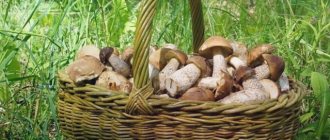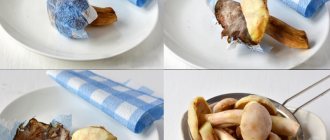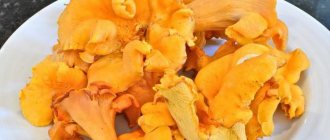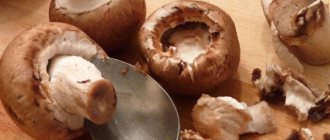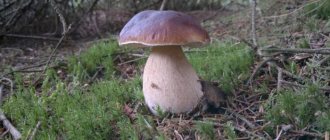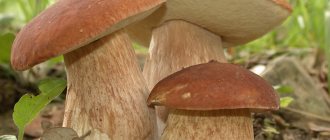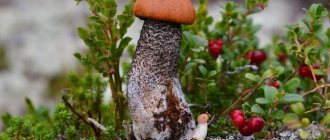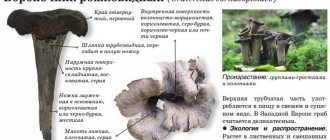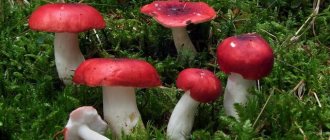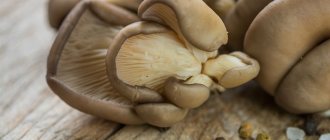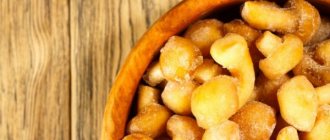Why do boletus turn wormy?
Many novice mushroom pickers wonder: why do boletus mushrooms become wormy?
The fact is that fruit flies and mosquitoes lay eggs on mushrooms, from which voracious larvae then emerge. Some worms live in apples, others in raspberries or strawberries, and some like butternuts. The best weather for insects is when it is dry, warm and sunny. Many mushroom pickers believe that there is nothing dangerous in wormy boletus if there are not so many of them. After all, even with industrial preparations, boletus that is less than half damaged is considered suitable for consumption. But if you collect mushrooms for yourself and your family, it is better not to take wormy ones. Follow the good mushroom picking rule: less is more.
Don’t rush to collect all the boletus in a row that are located in one clearing. It is better to protect your harvest in the basket from wormy mushrooms. Worms are so voracious that they can quickly destroy all the mushrooms you collect. However, if the mushroom picker followed all the precautions, but wormy boletus still ended up in the basket, what should you do?
A tasty and dangerous morsel
Rarely will a person refuse to eat mushrooms and ask: “why not?” This culture grows all over the world and is loved by a large number of people. However, besides us, there are other connoisseurs of their appetizing properties. Worms. Here are those who enjoy tasting and living inside what they think is an edible house.
Insects are found quite often in mushrooms. Both poisonous and edible. Especially in good warm and sunny weather. Hard larvae of beetles, flies, mosquitoes and other invertebrates do not harm their home. But they can have a much more negative and sometimes even lethal effect on human health.
Poisoning is the first sign that you have eaten a contaminated product. Therefore, carefully avoid such delicacies. Do not collect them and do not eat them under any circumstances. Don't become a new home for these creatures. After all, this is also not excluded. And this is a very compelling argument in favor of why you should not eat wormy mushrooms.
Summer is coming, which means that in just a little while, in addition to the summer season, the mushroom season will begin. There are people who don’t like to go into the forest and pick mushrooms, but hardly anyone can refuse rich mushroom soup, fried potatoes with mushrooms or pickled mushrooms with onions and vegetable oil.
But very often mushroom pickers note that there seem to be a lot of mushrooms, but some of them are wormy. Some people immediately throw these items away, while others, as if nothing had happened, put them in their baskets and buckets. So is it dangerous to eat wormy mushrooms? Let's try to find the answer to this question.
What to do with white wormy mushrooms
Not only humans like porcini mushrooms. This is the most delicious mushroom, for which there are always many people who want it. It is eaten by animals, birds and slugs. There are about 300 species of insects alone that settle in the fruiting bodies of porcini mushrooms.
Porcini mushrooms, just like the rest, can be soaked in a saline solution and dried to remove larvae.
Insects prefer to fly through the forest in dry, warm weather. Therefore, in the summer, porcini mushrooms quickly become wormy. In the fall, when it rains and is cool, you can count on intact prey.
So, a wormy mushroom is not always a candidate for the trash bin. But everyone decides for himself whether he will eat dishes from forest delicacies, knowing that they were once home to numerous larvae.
So that everyone is happy
You can save wormy mushrooms. But to do this or not, everyone decides for themselves. Not everyone can calmly eat forest delicacies, bearing in mind that quite recently worms lived in them. For such capricious mushroom pickers, there is only one way out - to put only whole mushrooms in the basket without a hint that someone has had time to taste them.
Already cut worm finds can be hung on a twig. They will dry out and become a treat for some bird or animal. Some nature lovers do just that. In this way they do a good deed for the forest inhabitants. And for yourself and your loved ones, if you wish, you can always pick up clean, unbitten, worm-free mushrooms. There may not be so many of them, but it will be more pleasant to eat. You can pamper your guests with your favorite delicacies.
But we must not forget one important rule - you need to be very careful with mushrooms, this is food that is difficult for the stomach; small children and people with poor health are not recommended to eat mushroom dishes. And you can collect forest gifts only in environmentally friendly places, away from roads. Then, even if they are a little wormy, they will not cause harm to health. Follow these simple requirements so that quiet hunting brings only joy and pleasure to you and your loved ones.
Why do mushrooms become wormy?
Special insects, fungus gnats and flies, lay eggs on fruiting bodies that have just emerged from the ground. In warm weather, the eggs quickly mature and larvae hatch from them. They feed on mushroom pulp, grow, turn into adult insects and fly away.
The mycelium does not suffer in this case. On the contrary, the larvae help move spores into the soil from the bottom of the cap. The mycelium becomes more viable and increases the number of mushrooms.
The mushroom picker gets upset when a young, delicious fresh boletus or saffron milk cap, cut with a sharp knife, turns out to be wormy. It is believed that wormy mushrooms are unfit for food and their only purpose is to be thrown away.
Tips on what to do with wormy boletus
If there are wormy boletus in the basket, use the following tips. First, cut off the damaged areas. At home, process all mushrooms, especially wormy ones. How to get rid of worms in boletus? To do this, cut each mushroom into two parts and immerse them in salt water for three hours. Then all the worms will float to the surface, and the eggs will sink to the bottom.
If you cut a very wormy mushroom in the forest, do not throw it on the ground. Simply prick the oil can onto the branch with the spores facing down. The hat in this position will not rot, but will gradually dry out. The spores will begin to fall out, and a new mycelium will appear nearby. And the dried mushroom will become food for forest animals in the winter.
Eating
A wormy mushroom does not cause poisoning, unlike a poisonous or inedible fruiting body. Old, overgrown specimens are usually affected by these pests. But these lose their taste, the flesh is hard or too friable with an unpleasant aroma. If you eat such a specimen, it will lead to indigestion and intoxication of the body.
If a spoiled boletus, boletus, or butter dish ends up in the hands of a mushroom picker, it’s worth putting in a little effort and preparing it for consumption. To do this, the fruiting body is cut into large pieces and filled with a solution of salt water. After 2 - 3 hours, when the pests emerge, the mushrooms are removed from the solution. At the same time, the water is not drained so as not to leave pests at the bottom of the dish. Then they are washed, dried and prepared for consumption in the chosen way.
Wormy mushrooms
Useful advice on what to do with wormy porcini mushrooms
The worms are running away like rats from a ship. Porcini.
Types of fungi
The interpretation of the dream largely depends on what kind of mushrooms were with the worms. Here's what some of them dream about:
- saw honey mushrooms - to loss of money;
- dreamed of chanterelles - to troubles and burdensome worries;
- saw the champignons - to self-deception and grief because of this;
- I saw a boletus - there will be obstacles on the way;
- saw oyster mushrooms - troubles await you at work;
- dreamed of boletus - the work into which you have invested a lot of effort will be in vain;
- whites saw - to health problems;
- toadstools or fly agarics appeared in dreams - to victory over spiteful critics.
We invite you to familiarize yourself with the Description of the self-fertile apricot variety “Alyosha”
We invite you to familiarize yourself with: What a truffle mushroom looks like
How to get rid of worms in mushrooms?
Many of you love mushrooms very much and willingly collect them or buy them at the market. Amazing! Mushrooms are very tasty and healthy. However, almost every mushroom picker or mushroom lover is faced with an unpleasant problem - wormy mushrooms.
Most often, we throw away all the mushrooms on which we see even a small hole. Remember: you cannot be poisoned by worms in mushrooms (unless these mushrooms are poisonous). Therefore, the problem of wormy mushrooms is more aesthetic.
The largest restaurants in the country buy mushrooms from private owners by the hundredweight, prepare a variety of dishes from them, and no one complains. Want to know where the worms go? Are all mushrooms really examined under a microscope?
Of course not. It’s just that restaurant chefs know very well how to get rid of worms.
Let's reveal their secrets:
- Buy only fresh mushrooms. They cannot be stored for more than 3 hours. The more they are stored, the more wormy the mushrooms become.
- Mushrooms picked in the rain will spoil especially quickly, so try to heat-treat your mushrooms as quickly as possible.
- If for some reason you cannot immediately deal with mushrooms, place them in water.
There are two ways to get rid of worms:
- Coarsely chop the mushrooms and place in a saucepan with salted solution. The solution is prepared as follows: 1 glass of salt per 5 liters of water. Porcini mushrooms are kept in solution for 3-4 hours. Russulas and pigs are less dense, so they should lie in the water less. Milk mushrooms are generally soaked for at least a day. Then the water is drained and the mushrooms are thoroughly washed in a colander. The worms will fall out into the brine solution.
- You need to dry the mushrooms. Worms fall out when dried. There are two ways. First you need to cut the mushrooms into thin slices, then string them on a thread and hang them. Just be sure to put something on the floor. After 24 hours, all mushrooms will be free of worms. Or (if there are a lot of mushrooms), mushrooms cut into thin slices are dried in the oven at the lowest temperature. Then the mushrooms are shaken off the dried worms that have crawled out.
In the oven, it is better to use something like a sieve with large cells, and place an ordinary baking sheet down. These simple devices allow you to immediately obtain clean mushrooms. All the worms will fall through the holes in the sieve onto the baking sheet.
That's all the simple secrets. If the information was useful to you, do not forget to share it on social networks
How to remove by soaking
It is worth getting rid of worms in mushrooms immediately after they have been collected. To do this, they need to be cut into large pieces. First, the leg of the body is cut off, the tubular layer at the cap is removed, and the leg is divided in half. The parts are placed in cool, salted water for several hours. For 5 liters of water you need to take 1 glass of salt.
It should be taken into account that different types of mushrooms have different densities. The peculiarity of preparing porcini mushrooms for consumption is that they should be kept in water longer than others - 3-4 hours. Milk mushrooms must lie in water for at least 24 hours. Russulas and pigs can be kept for a couple of hours.
Important! If the fruits are too spoiled, rotten or rotten, there is no point in saving them - there is nothing useful left in them.
If the worms have eaten only a small part of the body, you can simply cut off the damaged part with a knife. The main thing is that the fetus does not show signs of decomposition. Cleaned mushrooms can be fried, pickled, boiled, or pickled.
How to avoid wormy mushrooms
To reduce the likelihood of finding worms in mushrooms, you need to follow some simple tips:
- You should only buy fresh fruits. You need to start cooking immediately, before 3 hours have passed. The longer the storage period, the greater the chance that parasites will appear there.
- Mushrooms collected in the rain are especially susceptible to worms. After assembly, they must be immediately cleaned, boiled or stewed.
- If it is not possible to immediately heat the mushrooms, they should be placed in water.
- It is best to pick mushrooms at the end of summer, at the beginning of the first cold snap. This is the time of mass release of pests from the fruits. It does not last long - only 1-2 weeks, so you need to have time to visit your favorite mushroom places.
Finding the perfect mushroom, without traces of worms, is difficult. If a fruit has become home to a parasite, this is not a reason to throw it out of the basket. Mushroom pickers know: you can also make a delicious delicacy from wormy fruits.
How to save a wormy mushroom
Worms cannot tolerate salt. If you soak mushrooms in a saline solution, the larvae begin to leave the fruit caps and stems of the mushrooms. They can be removed from the surface of the water with a strainer. This sight will seem unpleasant to many, but the goal will be achieved - not a single parasite will remain in the mushrooms.
Processing of wormy mushrooms:
- Cut into large pieces.
- Place in cold, highly salted water.
- Leave for 3-4 hours.
The worms do not tolerate salt and begin to leave the fruit caps and stems of the mushrooms. They can be removed from the surface of the water with a strainer. The sight may seem unpleasant to many, but the goal will be achieved - not a single parasite will remain in the mushrooms.
We invite you to familiarize yourself with Durian: beneficial properties, contraindications, benefits and harms
Mushrooms soaked for 3-4 hours in saline solution are removed and washed. Then any dishes are prepared from them: boiled, fried, salted and pickled.
To get rid of insects, you can use not only salt, but also the sun. Drying cleans the fruiting bodies of all types of worms. Mushrooms laid out or hung to dry become an extremely uncomfortable place for the larvae, who are in a hurry to leave their “home.”
Dried mushrooms are stored in glass jars closed with a nylon lid. Shelf life 2 years. During storage, larvae do not “come to life” in them and new insects do not appear.
The larvae that fall out of the fruiting bodies during drying can be used - aquarium fish love mushroom worms.
We remove pests by drying
An equally effective method is drying fruits. Under the influence of the sun, deprived of moisture, all the worms will leave their place of residence. You can dry them in two ways. Mushrooms are cut into thin slices, strung on a thread and hung. The floor is covered with newspaper or paper. After a day, all the worms will come out.
The second way to remove parasites is to cut the mushrooms into plates, place them on a metal sieve and put them in the oven. You can place a baking tray underneath. The temperature should be set to the lowest possible. Afterwards, the fruits need to be cleaned of worms, which come out halfway during drying.
Instead of an oven, you can use a stove or an electronic dryer. It is better to store dried fruits in glass jars, tightly closed with a lid. This way, their shelf life will increase to two years - the larvae will not “come to life”, and new parasites will not appear.
There is another “lazy” drying option that will get rid of the larvae. Peeled mushrooms are laid out on paper and placed on the bottom shelf of the refrigerator. After two weeks, they can be removed and stored in a dry place. If you dry the fruits this way, they will taste more delicate.
Important! It is not necessary to throw away the worms that fall out of the mushrooms. This is an excellent food for aquarium fish.
How to dry porcini mushroom
To do this, the mushrooms are not washed, but only cleaned of debris and cut lengthwise into two or more parts (this depends on the size of the mushroom). Dry in the oven on a wire rack at a temperature of 50–70 degrees for 7–12 hours. They should be stored in a dry place in a tightly closed container. Dried porcini mushrooms retain their taste and nutritional properties in the best way; they can be eaten as crackers without additional processing.
The greatest advantage of the porcini mushroom is that it can be cooked all year round, namely, cooked in soups, fried, and used as a filling for pies. When dried, the mushroom does not lose its beneficial properties and unique aroma. For soups, dried mushrooms are soaked in warm water, washed and soaked in second water until completely swollen. After this, the mushrooms are cut into small pieces, and the water is used for broth.
At first glance, they can be compared to a “white worm”. But upon closer inspection, there are some noticeable differences. Worms and maggots often make mistakes. Maggots are the larvae of a fly or mosquito and are in the second stage of their life cycle. Worms, on the other hand, are part of the order of articulated annelids.
Maggots are fly or mosquito larvae. Flies can give birth to live larvae, but most often the larvae are produced from an egg that the fly lays in decaying organic matter. After five molts, the larva becomes darker and turns into a pupa. Pupa will hatch the take-off fly.
Features of cleaning different types of mushrooms
Each mushroom variety has specifics on how to properly clean them.
White
White is easy to clean, since its growth areas are dry areas and moss. The remaining soil on the stem is cut off and the cap is wiped. Damaged fragments are carefully trimmed.
Wormy mushrooms are useful in dried form. When dried, the worms crawl out, but the dense structure of the porcini mushroom retains its beneficial properties.
Boletus and boletus
Boletus and boletus are often wormy. They immediately check the leg by cutting off the tip. Large caps are separated and cut in half also to check for worms. More often, the worms are located in the lower part of the cap, leaving the upper part intact, so the spongy layer is removed with a knife.
The leg is cleaned by removing the top layer. The skin of the cap is sometimes peeled, although this is not necessary.
Butter
Butterflies are difficult to clean due to the slippery surface of the cap. The film covering the head becomes coarser and bitter after heat treatment, so it must be cut off.
To prevent the slippery film from sticking to your hands during the cleaning process, it is permissible to slightly dry the butter or pour boiling water over it.
In young specimens, only the mushroom stem is trimmed. For adults, the top layer is additionally scraped off and the collar under the hat is removed.
Chanterelles
Chanterelle mushrooms contain a substance that repels worms, so there is no need to clean chanterelle mushrooms. Their pre-cooking processing is limited to cutting off a third of the leg, where the remaining soil remains. Chanterelles are not peeled and no parts are cut off.
The only difficulty encountered in the process of cleaning these mushrooms is their unusual shape, consisting of plates, between which debris gets stuck. You can get rid of it by soaking, which is useful for chanterelles to give elasticity and strength.
Rizhiki and honey mushrooms
Honey mushrooms and saffron milk caps are considered the purest. To clean them, it is enough to remove the adhered leaves and needles, trim the tip of the mushroom stem with soil or sand and remove rotten and darkened fragments.
Champignon
Small young champignons are almost never cleaned; they only remove adhering dirt with a damp cloth, because during the washing process they lose their taste and absorb a lot of water. In adult large specimens, many prefer to remove the skin from the cap, which has lost its attractive appearance. This is done with a knife, moving from the edge towards the central part of the cap.
How to pre-clean mushrooms (Maslyata, Polish, chelyshi, aspen, white)
Milk mushrooms
Milk mushrooms are classified as mushrooms that must be soaked before cooking, so it is easy to clean the mushrooms from dirt by placing them in water. Cold water will also be a way to get rid of the bitter taste.
The container with soaked milk mushrooms is placed in a cool place so that the mass does not sour.
The soaked milk mushrooms are cleaned with a brush, knife or hard sponge until white, damaged areas are removed, and then finally washed.
Prevention is better than cure!
Avoid touching houseplants after you've cared for them in your garden without washing your hands or disinfecting gardening equipment. Systematically remove contaminated leaves. Weakened plants are more susceptible to pests and diseases. Strengthen your plants by regularly watering them with vegetable cooking water rich in mineral salts.
Do not leave fresh mushrooms for a long time, they contain substances that are hazardous to health and even life. Immediately sort and start cooking. As a last resort, put them in a colander, sieve or enamel pan and, without covering, put them in the refrigerator, but for no more than a day and a half.
Mushrooms collected in rainy weather spoil especially quickly. If you leave them in the basket for several hours, they will soften and become unusable. Therefore, they must be prepared immediately. But ready-made mushroom dishes cannot be stored for a long time - they will spoil.
In any case, even if these worms are harmless, it is better to take precautions by removing these larvae when potting or creating potted plants or planters. An earthworm is a small red worm ranging from 1 to 8 centimeters. These flying larvae feed on the soil and mainly on mold.
They primarily feed on root debris and microscopic fungi. They are harmless, they do not attack the plant or even the air on the ground. However, a compost larva that only lives ten days can still contain up to 200 eggs. And if they are harmless, when there are few of them, they run the risk of attacking plant roots.
To prevent peeled mushrooms from turning black, place them in salted water and add a little vinegar.
It is easy to remove the skin from russula if you first pour boiling water over it.
Be sure to remove the mucus-covered film from the butter before cooking.
Milk mushrooms require special processing. First, simply rinse them from sand, adhering earth and other forest debris. After this, carefully scrape the mushrooms with a sharp knife, removing the black layer and damaged areas. Then place in a large bowl of warm water and soak for three days to get rid of the bitterness.
We invite you to familiarize yourself with Hydrangea paniculata: planting and care, description of varieties
Therefore, when the parasitic pressure is too high, measurements are necessary. The worm, which is the larva of the taupine, is brown or yellowish. Millstone beetles are beetles that bury themselves underground until winter. The larvae feed on plant roots. In many crops, when these worms begin to attack a plant, it is almost always frowned upon.
If the attacked plant can still survive, it can be repacked, the roots thoroughly scraped to remove all soil and larvae, and replanted in new soil. Scrub the roots under water between your fingers to remove as much soil as possible. Remove faded parts of the plant and then transfer it to a pot of similar size and material filled with fresh soil.
Pavel Sokolovsky: notes for mushroom pickers, part 3
How to take mushrooms correctly: cut or twist?
This is a sore point.
There are mushroom pickers here, so many opinions. Here is what Doctor of Biological Sciences L.V. Garibova writes about this: “Mushroom pickers are often concerned with the question: how to pick mushrooms correctly - cut or twist? The answer is simple: mushrooms should be collected as convenient as possible. Tubular ones are easier to unscrew, they have a dense leg, while plate ones are easier to cut off, since their hollow leg is very fragile and will crumble if you try to unscrew it. The main thing is not to dig up the forest floor, so as not to damage the delicate thin mycelium located in it. The hole formed after the mushroom has been removed should be covered with earth or bedding. With such precautions, the mycelium in this place will bear fruit repeatedly.” Up... What to do if the mushroom turns out to be wormy?
If, after cutting a mushroom, you see that it is wormy, you can proceed in three ways.
Firstly, you don’t have to take it at all. In this case, leaving the mushroom on the ground, and even turning the cap upside down, as is sometimes done, is not worth it. Experienced mushroom pickers advise placing the cap of a wormy mushroom on a spruce branch, or pricking it on a dry one, “spores down.” At the same time, the cap does not rot, but dries, ripens and spreads dust over a large area (you'll see that several new foci of mycelium will appear). In addition, the mushroom dries and in winter, at the most hungry time, it may please some hare, squirrel or bird. Your work is 5 seconds, but the benefits are great. If each mushroom picker gets at least 20-30 “pricks” per trip, then there will be more and more mushrooms. Secondly, you can cut it into two halves along the entire length from the top of the cap to the end of the stem and see if the entire mushroom has become wormy. If it turns out that the cap is clean, you can cut off the stem and take only two halves of the cap. Thirdly, you can take the whole wormy mushroom if it is not completely flabby and old. At home, you need to cut it and put it in highly salted water for several hours (1-2 tablespoons of salt per medium-sized pan). After such a “bath”, all the larvae will crawl out of the mushroom. Then the salt water should be drained and the mushrooms should be washed thoroughly. The disadvantage of this method is that although the larvae crawl out, their waste products may remain in the mushroom. Up... How to “reliably” distinguish a non-poisonous mushroom from a poisonous one?
There is only one correct way - to examine the mushroom and determine its type by its characteristic features. There are no other reliable methods. However, in order to reduce the risks, it is advisable to remember the following tips: 1. Never collect or eat those mushrooms that have a tuberous thickening at the base of the stem, surrounded by a shell (pale toadstool, fly agaric). Attention: collect mushrooms only with a whole stem, so as not to lose sight of this important sign! 2. Never taste mushrooms or lick them. So you still won’t be able to determine anything, and poison (even in microscopic doses) can cause significant harm to the body. 3. If you have even the slightest doubt about the “edibility” of a mushroom, it is better to throw it away. 4. Try not to pick mushrooms after a long period and hot weather - during drought they lose water, their metabolism changes, which leads to the formation of unpleasant toxins even in noble mushrooms. 5. Do not collect old, spoiled, rotten, soft, overripe mushrooms. The balance of substances in them is disturbed. 6. Don’t trust drawn pictures of mushrooms in books - as a rule, they are far from reality. (See also the question about external toxins and radiation below.) There are very dangerous, but unfortunately deeply ingrained misconceptions about supposedly “reliable” methods of identifying poisonous mushrooms. You need to know them, never use them, and warn your friends and neighbors about the danger. Attention: the methods below are dangerous to life! They must not be used under any circumstances! Misconception 1. “Poisonous mushrooms can be “identified” using a silver spoon or onion.” Mountain experts claim that if you put a silver spoon in a saucepan with soaked mushrooms, then, if there are poisonous mushrooms, the spoon will turn black, and if you put an onion, it will turn brown. This is wrong. This testing method is similar to checking a gas leak with a burning match - it works until the first (and last) explosion. Misconception 2. “Insects do not eat poisonous mushrooms” Allegedly, if a mushroom is thoroughly nibbled by a snail, this indicates its suitability for food. This is wrong. The human body is very different from the insect body, and what is suitable for snail food can be deadly for humans. Misconception 3. “Poisonous mushrooms become edible after salting or pickling.” This is completely untrue. Pale toadstool can send you to the next world both in salted and pickled form. Misconception 4. “The poison from mushrooms can be removed by boiling them for several hours.” This is a dangerous mistake. The poisons of most mushrooms are heat-resistant and it is impossible to turn a toadstool into a honey fungus by boiling. Up…
Preparing mushrooms
It is better to sort mushrooms into healthy ones and wormy ones right in the forest. The wormy parts should be cut off immediately and thrown away. If they remain in the basket, the worms will move to an adjacent uninfected fruit. The wormy body can be pricked on a twig - the spores will spread in the air, and next year there will be a generous harvest in that place.
The first thing to do is to make sure that worms are actually present in the fruit. You can check this by cutting them along their entire length into two parts.
Butterfish are the most susceptible to worms. Already on the second day of regrowth, the larvae begin to eat their legs. If there is any doubt whether the honey fungus is wormy, you need to trim its stem shorter. As a rule, the passages end under the cap - such a mushroom can be eaten. There are practically no parasites in forest champignons.
Worms are almost invisible in fried or stewed fruits. But if you cook the broth, an unpleasant situation is possible, so it is advisable to strain it before serving.
Useful tips for quickly cleaning oil
- Clean the stems of the mushrooms from dirt, inspect the caps, remove the skin, cut into pieces if they are large.
- Do not soak the mushrooms before cleaning; the film will swell and be difficult to remove.
- When collecting mushrooms in the forest, remove their skins. Then the cleaning process at home will take less time, and you will be in the fresh air longer.
- An oily, dark-colored coating settles on your hands, so when going into the forest to pick mushrooms, take gloves with you.
Rules for collecting mushrooms
Basic rules that will help make mushroom picking as easy and successful as possible:
- Mushrooms are collected in forests or on their edges. Find out from other mushroom pickers from your favorite gathering places. Or use a mushroom map of the area.
- The mushroom picker’s equipment should be light and comfortable, the knife should be sharp and, as they say, “fit the hand,” and a wicker basket in which there is constant air movement is suitable for transporting mushrooms.
- The best time to collect is early morning, when the sun's rays have not yet dried the dew on the caps of the fruiting bodies.
- It is better to collect those mushrooms that you are completely sure are edible. It is better to throw away those that cause even the slightest doubt, so as not to spoil the entire harvest.
- To preserve the mycelium, it is better to cut the mushrooms at the base or carefully twist them out of the ground. After this, it is advisable to sprinkle the cut (twisting) area with earth.
- Preference should be given to young mushrooms without damage. Do not rush to throw away slightly wormy mushrooms. They can be folded separately or, after removing damage, they can also be sent to the basket.
- The cut mushroom is carefully inspected and soil and debris are removed. It is preferable to put them in a basket with the caps down to save space and prevent breakage and damage. In addition, larger and heavier specimens are usually placed at the bottom of the basket, and small and light ones at the top.
- It is better to process the harvested crop immediately after returning. If stored for a long time, they deteriorate and lose their taste.
Preventive measures
Is it possible to dry wormy mushrooms?
The question is cool and ridiculously attractive...) And since it was asked by an experienced, seasoned consultant, it may well turn out to be a rating question...) That’s why I’ll answer.
Of course, this question could sound something like this: “How to dry wormy mushrooms so that they become suitable for eating?”, or like this: “Is it harmful to eat wormy mushrooms?” But still, it’s better to leave the question as it is - in its original form...
Firstly. It’s clear that you can dry anything: mushrooms together with worms, and even worms from mushrooms separately. Especially if the eater is a kind of gourmet and his fermentation is adjusted in accordance with his gastronomic preferences. In this case, such a gourmet is not threatened with any unpleasant consequences, and dried wormy mushrooms are the most familiar delicacy for him...)
Secondly. Speaking seriously, it is quite possible to consider a life situation where there is simply nothing to eat, and civilization is a long way from the dense forest. There is nothing around - except for an abundance of wormy mushrooms... Then you will have to use these mushrooms for food. Only with wormy mushrooms you will need to do some manipulations before hanging them to dry. You need to dissolve a good handful of coarse table salt in a pot of cold water and place the wormy mushrooms, cut in half, in there for at least half an hour. Worms cannot tolerate salt and will quickly leave their feeder. And then you can dry the mushrooms in the shade in the breeze, and then cook them and eat them. Some worms will still remain in the mushrooms, but this is not dangerous to health. Besides, hunger, as you know, is not a problem...)
And thirdly. I am sure that today it is better to completely refuse to collect forest mushrooms near Moscow. Even if they are intact and not at all affected by the worm. Over the past decades, myceliums have managed not only to incorporate the periodic table, but have also mutated significantly. Sometimes you can’t distinguish an ordinary little russula from a pale toadstool, which has lost its traditional skirt in the foliage. And a dangerous poisonous mushroom successfully passes itself off as a sturdy boletus. I suggest Muscovites focus their attention on greenhouse mushrooms (champignons, chanterelles or oyster mushrooms), there are now plenty of them on the capital’s shelves. And you can dry them as much as you want. I insist on my opinion as a lover of mushroom hunting with serious experience. I now refrain from picking mushrooms in the Moscow region. I put a ban on wild mushrooms for myself from that tragic moment when the insidious pale toadstool killed my close friend, and the famous Moscow professors could not help her. It was too late to save...
0
Fresh mushrooms, collected in the forest or bought at the market, need to be quickly prepared for culinary processing. Only then will they retain their taste and be elastic and aromatic.
Dishes made from properly peeled and chopped mushrooms turn out beautiful and appetizing.
The main rule is that cleaning mushrooms cannot be put off for too long. Cut mushrooms in a warm room deteriorate and quickly become flabby. They easily lose their unique forest spirit. After a trip to the forest, you need to get down to business as soon as possible.
If this is not possible, you can store your prey until the morning in the refrigerator or other cool place, for example, in a cellar.
What tool should I use to quickly clean?
To do this you will need a small sharp knife. The thin tip is convenient for removing damaged areas and cleaning out debris. A sharp blade will cut fragile flesh easily and will not crumble it.
A damp cloth or paper towels are useful for wiping off dried-on dirt.
Mushroom juice contains substances that turn your fingertips black. Use gloves to protect your hands while working.
Prepare an empty container for clean mushrooms and water for washing.
Is it necessary to wash?
When washed, mushrooms absorb a lot of moisture and lose their taste. Therefore, it is better to limit yourself to dry cleaning where possible. Mushrooms that you are going to dry for the winter should not be wet under any circumstances; they can only be wiped with a damp cloth. Before frying, it is also better to do without washing, but if necessary, you can quickly rinse with water.
- cooking;
- pickling;
- marinating.
Mushrooms for pickling, which have a bitter taste, are soaked in cold water for one or two days, regularly replacing it with fresh water.
Preliminary processing
The first stage of cleaning takes place in the forest. Large debris is removed from the found mushroom: twigs, leaves, pine needles. The root is cleaned with a knife from soil and sand or simply cut off to check for worms inside.
Under no circumstances should you take unfamiliar varieties. Even one edible mushroom in a basket can lead to poisoning.
Also leave very wormy, moldy and very old specimens in the forest. They will spoil the taste of food and can be harmful to health.
Mushrooms purchased in a store or market have already undergone primary purification. Only small debris or traces of soil remain on them. At home, such mushrooms should be sorted again, damaged areas should be trimmed and, if necessary, washed. After this, you can cook and eat them.
White
Porcini mushrooms are not only the most delicious, they are also easy to clean. They usually grow in light, dry places or in moss. For these noble beauties, the soil is only cut around the circumference of the root. It is enough to wipe the hat or fan it with a brush. Carefully cut off areas damaged by forest inhabitants.
White ones, which are only slightly affected by worms, can be used for harvesting for the winter. During the drying process, the worms do not eat the mushroom from the inside, but crawl out.
boletus
Boletus mushrooms are often wormy; to check, the tip of their stem is immediately cut off. For large specimens, for the same purpose, the cap is separated and cut in half. There may be worms at the bottom of the cap, even if the rest of the mushroom is not affected by them. Then the spongy layer is completely removed. The leg is cleaned with a knife, removing the top layer of skin, although some mushroom pickers believe that this is not necessary.
Older boletuses have legs that become hard and fibrous. In cooking, it is better not to use such parts at all.
The video shows how to properly clean boletus mushrooms.
Boletus
Boletus mushrooms are processed in the same way as boletus mushrooms. The top layer is scraped off the stem. There is no need to remove the skin from the cap; just wipe off the dirt with a cloth. The spongy bottom of the cap should be checked for the presence of worms and fungus gnat larvae. Boletuses are distinguished by the fact that they turn blue and then turn black when cut. To prevent this from happening, it is recommended to immediately throw the pieces into water after cutting.
Cute mushrooms grow in large families, and it’s not easy to cope with a whole mountain of butter mushrooms. Difficulties arise due to the slippery film that covers the heads of the oil.
When cooked, it becomes rough and slightly bitter. Hats must be cleaned. To prevent the film from sticking to your hands, the butter is dried. Another popular way is to pour boiling water over them.
You can lubricate your hands with oil or wear gloves, otherwise the sticky skin will darken your fingertips.
Otherwise, young butterflies only have their legs trimmed. In older ones, you can lightly scrape the stem and remove the remnants of the collar under the cap.
Chanterelles
Red aromatic fungi are remarkable because they contain a substance that repels worms. They do not need to be peeled or any parts separated. For cleaning, only cut off the lower third of the stem with traces of soil. Chanterelles have a rather bizarre shape. Earth or needles get stuck between the plates, which are not easy to remove.
Fortunately, chanterelles can be washed in plenty of water. To make them more elastic and not break, they are doused with boiling water. This simplifies subsequent processing.
For large champignons, remove the skin from the caps. This is done by simply moving the knife, from the edge to the center. You can leave the top layer on the caps of young mushrooms. If the legs of the champignons are too harsh, cut them shorter or remove them completely. The collar is edible and does not need to be peeled off.
When washed, champignons absorb water strongly and lose their taste. Try to do it dry and shake off all the debris with a cloth.
If that doesn’t work, you can quickly rinse and drain the champignons in a colander.
Oyster mushrooms
Oyster mushrooms are very convenient to clean. They grow on tree trunks, so grass and needles practically do not stick to them. These mushrooms are good only when they are young; when sorting, old specimens are immediately removed and put aside. Select for food those whose cap is no more than 10 cm. Cut off the bottom of the stem, damaged edges and dried places on the fruiting body. It is convenient to wash oyster mushrooms in a sieve under running water, but you can also soak them in a basin.
Honey mushrooms
Honey mushrooms with long thin legs grow on stumps and practically do not get dirty. You just need to collect leaves and needles from them and trim the tips of the legs. If the lower part of the leg is too harsh, it is also cut off. The skin is not removed from the cap. However, rotten and darkened areas must be removed.
It is believed that saffron milk caps are the cleanest mushrooms, but they still need to be processed. Sticky blades of grass, twigs and needles are cleaned off with a brush or knife.
Saffron milk caps are often found on sandy soils; sand sticks to the roots and on the underside of the caps. It can be easily washed off along with other foreign particles by briefly soaking the saffron milk caps in a basin. When collecting in the forest, they are not pulled out of the ground by the roots, but immediately cut off with a knife. If you brought them home whole, then the roots will have to be cut off.
Milk mushrooms
The milk mushrooms are first simply washed and cleared of sand and other debris. They are then soaked in cold water for three days to remove the bitter taste. The water needs to be changed several times a day. Place the container with mushrooms in a cool place so that they do not sour. Using a brush, knife or hard sponge, scrape the soaked milk mushrooms until white. Then the damaged areas are finally washed and removed.
First of all, the raincoats are washed, carefully rubbing off the dirt with your fingertips. The outer layer, similar to a soft shell, is separated from the pulp. For large mushrooms, it is convenient to remove this skin with a knife. For control, spherical fruiting bodies are cut in half. If the flesh is white and elastic, it can be eaten.
Raincoats with a yellowish center should be thrown away. They are either old or damaged. Puffballs are not poisonous, but a mushroom with a bad taste will ruin the dish.
After dry cleaning, mushrooms can be stored in the refrigerator for a short time, but after washing, they must be cooked immediately. For soup, solyanka or preparations (except for drying), you can boil them for future use with a small amount of salt and then use them for several days.
To ensure that the culinary masterpiece subsequently looks beautiful, the mushrooms are carefully cut into pieces of equal size. The fibrous stems are cut crosswise, and the caps into triangular segments. Small mushrooms can be eaten whole; they look especially beautiful in jars with marinade. The goal of careful and proper processing is to preserve the valuable qualities of mushrooms in order to fully reveal them when preparing delicious dishes.
There is probably no person who has never been to the forest. Some people go there just to relax, take a walk or get some fresh air. And someone goes and “hunts”, in this case we mean “quiet hunt”, i.e. mushroom picking. And everything would be fine, but not everything is so smooth here either. Sometimes you start cutting a mushroom to put it in a basket, and you see - it’s wormy! Is it worth taking such “loot” home? What's the best way to proceed? And in general, is it possible to eat wormy mushrooms? You will now learn about this and much more.
